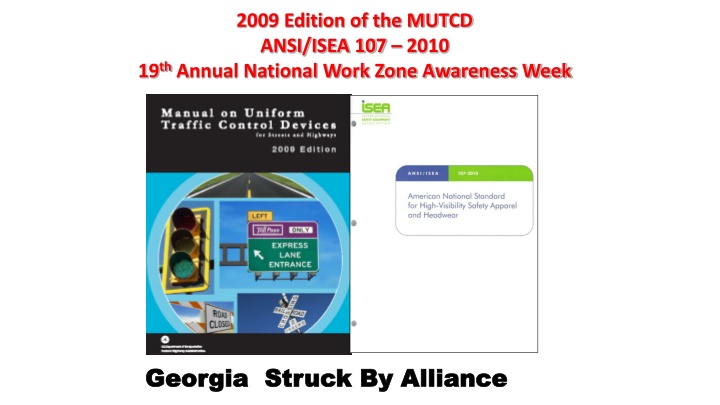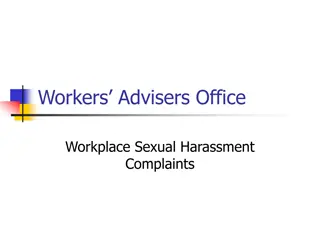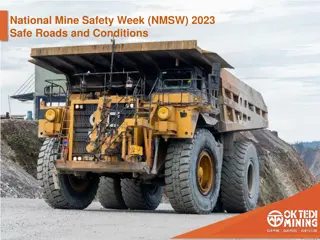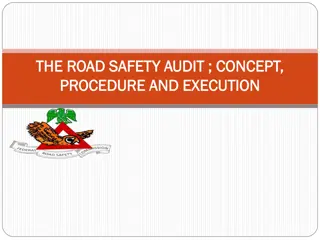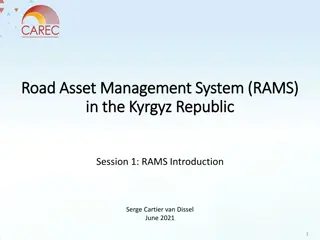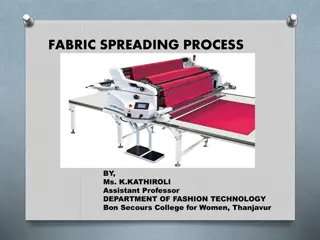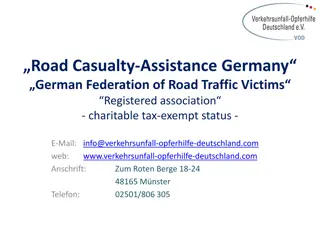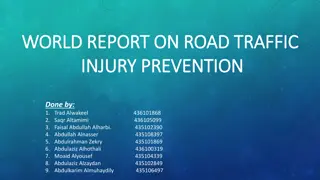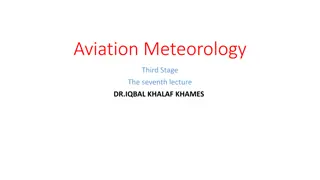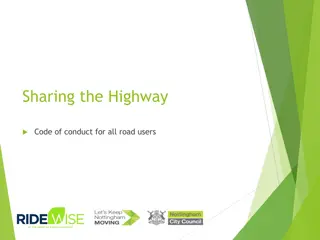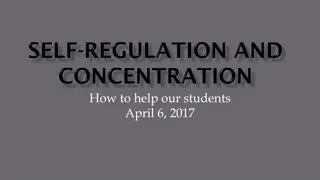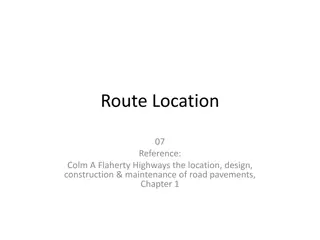Regulation on High-Visibility Apparel for Road Workers
The 2009 edition of the MUTCD and ANSI/ISEA 107 outlines the guidelines for high-visibility safety apparel for workers on streets and highways in the U.S. Compliance with ANSI/ISEA 107-2010 is mandatory, with specific requirements on classes of safety apparel. The use of ANSI/ISEA 207-2006 garments is also permitted for certain emergency responders and law enforcement officers. Learn more about the regulations and standards in place for ensuring worker safety in work zones.
Download Presentation

Please find below an Image/Link to download the presentation.
The content on the website is provided AS IS for your information and personal use only. It may not be sold, licensed, or shared on other websites without obtaining consent from the author.If you encounter any issues during the download, it is possible that the publisher has removed the file from their server.
You are allowed to download the files provided on this website for personal or commercial use, subject to the condition that they are used lawfully. All files are the property of their respective owners.
The content on the website is provided AS IS for your information and personal use only. It may not be sold, licensed, or shared on other websites without obtaining consent from the author.
E N D
Presentation Transcript
2009 Edition of the MUTCD ANSI/ISEA 107 2010 19th Annual National Work Zone Awareness Week Georgia Struck By Alliance Georgia Struck By Alliance
2009 MUTCD Edition Streets and Highways The MUTCD is now the primary regulatory document mandating the use of high-visibility apparel for all affected workers in the U.S. Mandatory use areas are expanded beyond Federal-aid highways and now includes all roads open to public travel, i.e., any road where you can drive a car without passing through a traffic control gate, including private property. A link to the full text of 2009 MUTCD: http://mutcd.fhwa.dot.gov/pdfs/2009/mutcd2009edition.pdf
2009 MUTCD Edition for Streets and Highways Any agency should do its best to insure compliance with the most current edition of ANSI/ISEA 107; which is ANSI/ISEA 107 2010, The American National Standard for High Visiblity Safety Apparel & Headwear All workers, including emergency responders, within the right-of-way are required to wear high-visibility safety apparel that meets performance Class 2 or 3 of ANSI/ISEA 107-2004, or equivalent revisions (ANSI/ISEA 107 2010).
2009 MUTCD Edition for Streets and Highways Fire resistant (FR) labeling requirements may need additional clarification. Any garment label that includes reference to NFPA FR Standard 701 do not meet the FR requirements for ANSI/ISEA 107 2010. The use of ANSI/ISEA 207-2006 Public Safety Vest compliant garments is included as an option for emergency and incident responders and law enforcement officers to meet requirements of this regulation in lieu of ANSI/ISEA 107-2004. When uniformed law enforcement personnel are used to direct traffic, to investigate crashes, or to handle lane closures, obstructed roadways, and disasters, high visibility safety apparel shall be worn.
ANSI/ISEA ANSI/ISEA 107 107- -2004 2004 & ANSI/ISEA 107 & ANSI/ISEA 107 2010 Class 2 or Class 3 Class 2 or Class 3 ONLY MUTCD Apparel Options MUTCD Apparel Options 2010 ONLY Examples of non-compliant safety vests ANSI 2004 or ANSI 2010 Class 1 is not allowed for workers on any federal aid right of way, any street or road; public or private. Examples of ANSI 2004 or ANSI 2010 Class 3 compliant apparel Examples of ANSI 2004 or ANSI 2010 Class 2 compliant apparel Vest at top with two bands around the body are non compliant to ANSI 210 5
2009 MUTCD Edition Streets and Highways Section 6D.03 Worker Safety Considerations A trained person designated by the employer should conduct a basic hazard assessmentfor the worksite and job classifications required in the activity area. This plan should be in accordance with the Occupational Safety and Health Act of 1970, as amended, General Duty Clause Section 5(a) (1) Public Law 91-596, 84 Stat.1590.
2009 MUTCD Edition Streets and Highways Section 6D.03 Worker Safety Considerations The following are the key elements of worker safety and TTC (Temporary Traffic Control) management that should be considered to improve worker safety: A. Training all workers should be trained on how to work next to motor vehicle traffic in a way that minimizes their vulnerability. Workers having specific TTC responsibilities should be trained in TTC techniques, device usage, and placement.
2009 MUTCD Edition Streets and Highways Section 6D.03 Worker Safety Considerations B. Temporary Traffic Barriers temporary traffic barriers should be placed along the work space depending on factors such as lateral clearance of workers from adjacent traffic, speed of traffic, duration and type of operations, time of day, and volume of traffic. C. Speed Reduction reducing the speed of vehicular traffic, mainly through regulatory speed zoning, funneling, lane reduction, or the use of uniformed law enforcement officers or flaggers, should be considered.
2009 MUTCD Edition Streets and Highways Section 6D.03 Worker Safety Considerations D. Activity Area planning the internal work activity area to minimize backing-up maneuvers of construction vehicles should be considered to minimize the exposure to risk. E. Worker Safety Planning a trained person designated by the employer should conduct a basic hazard assessment for the worksite and job classifications required in the activity area. This safety professional should determine whether engineering, administrative, or personal protection measures should be implemented. This plan should be in accordance with the Occupational Safety and Health Act of 1970.
2009 MUTCD Edition Streets and Highways Section 6D.03 Worker Safety Considerations The following are additional elements of TTC management that may be considered to improve worker safety: A. Shadow Vehicle in the case of mobile and constantly moving operations, such as pothole patching and striping operations, a shadow vehicle, equipped with appropriate lights and warning signs, may be used to protect the workers from impacts by errant vehicles. The shadow vehicle may be equipped with a rear- mounted impact attenuator.
2009 MUTCD Edition Streets and Highways Section 6D.03 Worker Safety Considerations B. Road Closure if alternate routes are available to handle road users, the road may be closed temporarily. This may also facilitate project completion and thus further reduce worker vulnerability. C. Law Enforcement Use in highly vulnerable work situations, particularly those of relatively short duration, law enforcement units may be stationed to heighten the awareness of passing vehicular traffic and to improve safety through the TTC zone.
2009 MUTCD Edition Streets and Highways Section 6D.03 Worker Safety Considerations D Lighting for nighttime work, the TTC zone and approaches may be lighted. E. Special Devices these include rumble strips, changeable message signs, hazard identification beacons, flags, and warning lights. Intrusion warning devices may be used to alert workers to the approach of errant vehicles.
2009 MUTCD Edition Streets and Highways Section 6E.01 Qualifications for Flaggers Because flaggers are responsible for public safety and make the greatest number of contacts with the public, of all safety workers, they should be trained in safe traffic control practices and public contact techniques. Flaggers should be able to satisfactorily demonstrate the following abilities: A. Ability to receive and communicate specific instructions clearly, firmly, and courteously; B. Ability to move and maneuver quickly in order to avoid danger from errant vehicles;
2009 MUTCD Edition Streets and Highways Section 6E.01 Qualifications for Flaggers C. Ability to control signaling devices (such as paddles and flags) in order to provide clear and positive guidance to drivers approaching a TTC zone in frequently changing situations; D. Ability to understand and apply safe traffic control practices, sometimes in stressful or emergency situations; and E. Ability to recognize dangerous traffic situations and warn workers in sufficient time to avoid injury.
